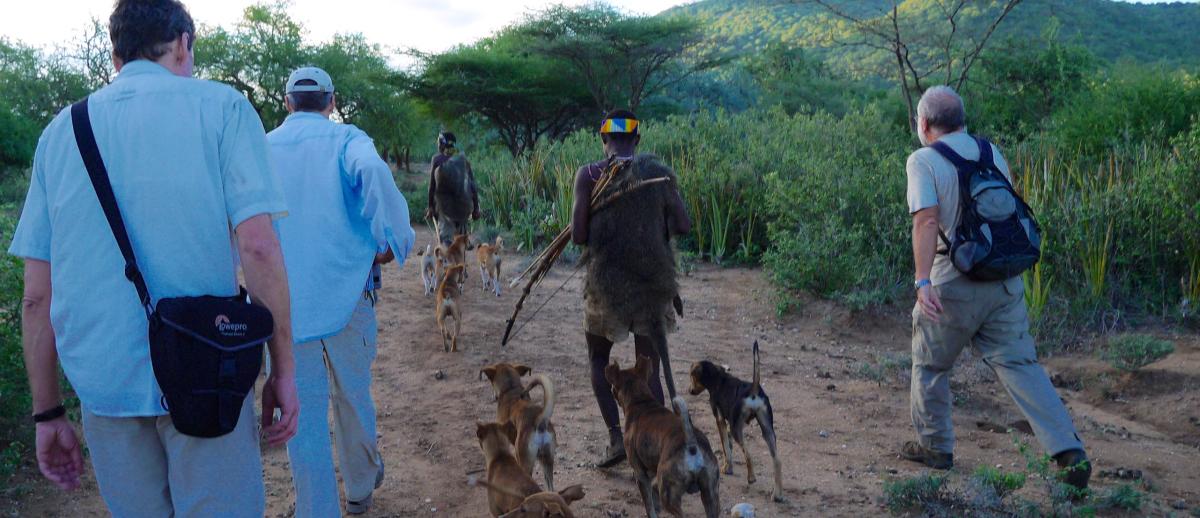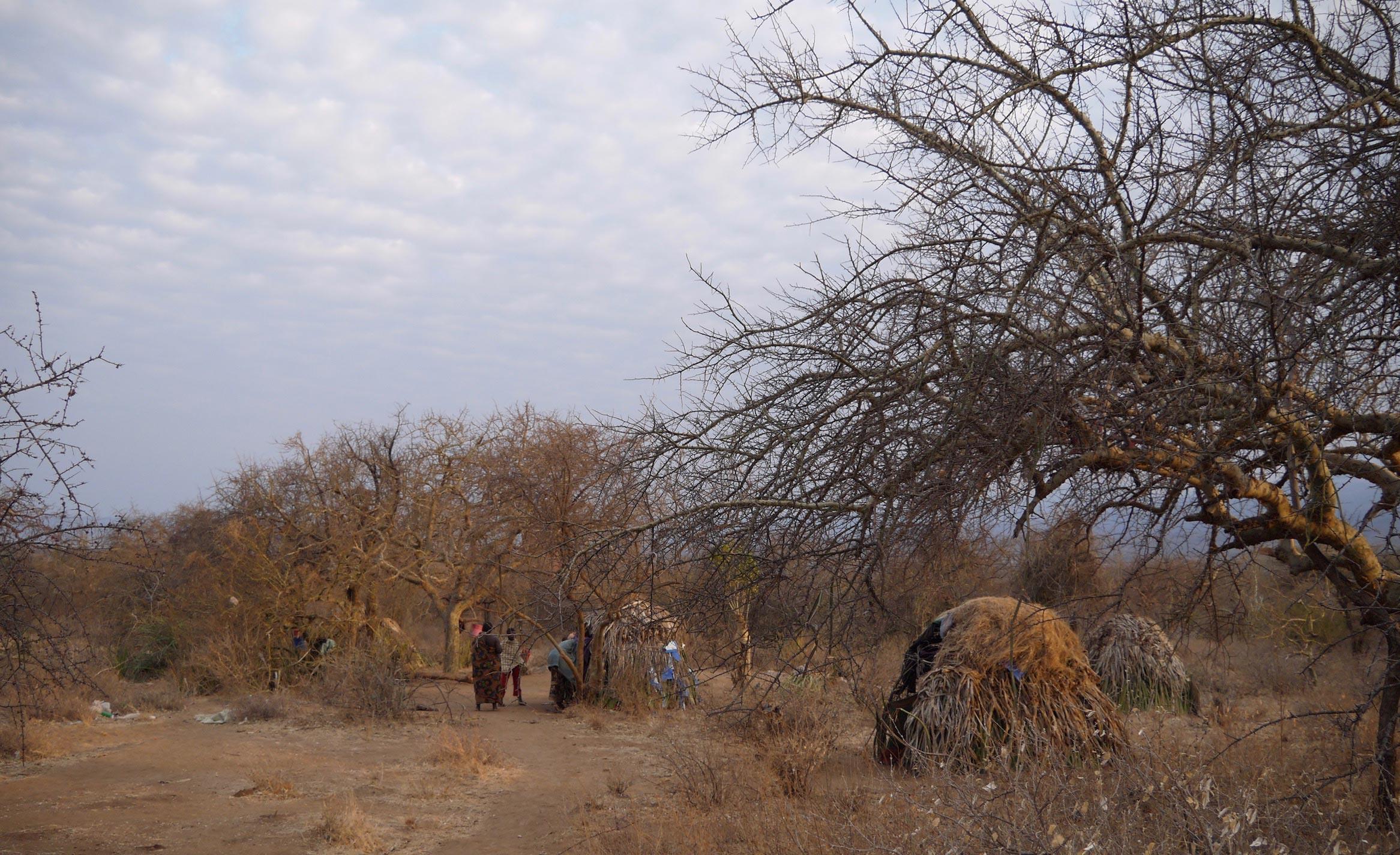Sustainable Hunting as Commodity: The Case of Tanzania’s Hadza Hunter-Gatherers
archive


Figure 1. Tourists follow Hadza men on a hunt. (Photo: Yatsuka Haruna)
Sustainable Hunting as Commodity: The Case of Tanzania’s Hadza Hunter-Gatherers
When the sun began to rise, the man who was walking in front of us stopped, crouched, and peered into the bush attentively. We also stopped without making a noise. Suddenly the man shot his arrow and ran into the bush, emerging with a small bird in hand. The tourists who were there frenetically snapped pictures while praising this “amazing” performance of an authentic and traditional way of life.
In northern Tanzania, ethnic tourism based on the Hadza hunter-gatherer culture developed in the 1990s. The Hadza hunter-gatherers, an indigenous population numbering less than one thousand, live near Lake Eyasi. They carry out their nomadic lifeways in small settlements called ‘camps’, which they frequently move in accordance with the rise or fall in surrounding natural resources and which typically involve around ten households each. The Hadza have been living off the natural environment for as long as anyone can remember, and represent a vanishing form of subsistence in an era in which more and more rural people around the world are migrating to cities and megacities. This makes the Hadza an especially exotic destination for the global tourism sector.
Subsistence hunting and ethnic tourism in Tanzania
Hunting, the most popular Hadza activity for tourists, is unique for tourism in Africa since it is completely different from sports hunting (also known as trophy hunting). In sports hunting, tourists pay a hunting tax for each animal and hunt it for sport or recreation. With the Hadza, on the other hand, tourists follow and photograph hunters while they are tracking animals with their traditional bows and arrows. Their purpose is to witness the Hadza’s hunter-gathering lifestyle.
The history and current regulation of hunting in Tanzania is complex. The German colonial administration introduced the first legislative provisions to control hunting in 1891. Hunting licences were introduced during the later British colonial period. Colonial laws gave local communities hunting rights—with the exception of certain species—since meat was such a central part of the local diet. Under these hunting laws only three ethnic groups—which included the Hadza—were allowed to hunt animals that ordinarily required a licence. The provisions were aimed at maintaining the traditional hunting lifestyle of the ethnic groups.1 In 1974 the post-colonial Tanzanian government passed the Wildlife Conservation Act which restricts hunting without a licence. By paying a regulation fee, such a licence can be obtained by both residents and foreigners. With the further passing of the Tanzania Wildlife Management Authority Act in 2013, the government may declare any community a ‘traditional community’ for the purpose of the Act and may grant the community a licence to hunt. The Hadza have been granted this licence under the 2013 Act’s provisions,2 the only ethnic group of Tanzania entitled today to hunt for their subsistence and thus a significant factor in the maintenance of their hunter-gathering culture. The case of the Hadza is therefore truly unique.
The nature of Hadza tourism
The famous tourism sites of Northern Tanzania include the Serengeti National Park and the Ngorongoro Conservation Area, both of which are World Heritage Sites. Mang'ola ward, to the east of the Hadza settlement area, provides good access from those famous reserves and is the main site of Hadza tourism (see Figure 2). Although the Datoga pastoralists—also an indigenous group from northern Tanzania—have lived in Mang’ola, for several centuries, many non-Hadza have settled in the area since the 1940s.3 Most of them are farmers from elsewhere who had come to Mang’ola to cultivate onions using irrigation. Today, many ethnic groups live around the Hadza.

Firgure 2. Map showing the research site
Since the 1990s, foreign tourists have travelled to Mang'ola to watch birds around the lake and to see the Hadza.4 While there were few tourists in the 1990s, the numbers have increased since the 2000s.5 In 2011, the Lake Eyasi Cultural Tourism Programme (hereafter called the ‘Programme’), a government-registered tourism office, was established in Mang’ola. Today, this Programme acts as a gateway for Hadza tourism and employs about fifty non-Hadza people who are registered as local tour guides.
There are about fifteen Hadza camps in Mang’ola, all of which are bush camps (see Figure 3). During my December 2012 stay in Camp A, my research site, there were around 40 Hadza locals. They often changed camps, however, and on each consecutive research visit the camp residents were different. In five research visits from 2012 to 2016, only two camp residents remained the same.

Figure 3. A Hadza bush camp (Photo: Haruna Yatsuka)
Hadza tourism follows a basic pattern. Typically, tourists arrive at Camp A by car around 6:00 a.m. They come with a local tour guide who belongs to the Programme and acts as interpreter between the Hadza and tourists. Tourists first observe the Hadza make fire with sticks, then go hunting with the men and their dogs, spending about two or three hours in the bush (Figure 1). Sometimes they accompany Hadza women gathering edible tubers. On their return from the hunting excursion tourists can try their hand using the traditional bows and arrows, observe traditional Hadza dance, and purchase handmade souvenirs. At around 10:00 a.m. they leave Camp A, some of them visiting Datoga blacksmiths who live near the Hadza settlement.
During my three-week research stay in Camp A in December 2012, forty tourist parties, consisting of around 146 persons, came from twelve countries including Tanzania. Some tourists got information about the Hadza through tourism companies in the regional capital Arusha, but many of them had learned about Hadza tourism in their home countries via internet searches and social media.
The Hadza [are] the only ethnic group of Tanzania entitled today to hunt for their subsistence... a significant factor in the maintenance of their hunter-gathering culture.
The Hadza receive two types of income from tourism, of which one is the entrance fee that amounts to about US$10 per tourist party for Camp A. Most of this money is used for purchasing maize flour for their staple food as well as beer made by agriculturalists in neighbouring districts. The second type of income is from selling handmade souvenirs such as beaded accessories and small bows and arrows. The cash generated from such sales goes directly to the Hadza person who made the souvenirs.
Their foraging life and the impacts of Hadza tourism
As Woodburn6 has noted, the foraging lifestyle of the Hadza has long been negatively impacted by the in-migration of other ethnic groups into their settlement area. Moreover, the growth of tourism in Mang'ola has had mixed effects. Tourism makes it easier to earn money and to have stable access to agricultural products such as maize flour. On the other hand, hunting for tourism does not contribute significantly to the Hadza’s diet. On most excursions involving tourists, the hunt is for small animals such as birds and squirrels, hardly a major staple. They are actively hunted because doing so provides one of the few opportunities for tourists to witness traditional hunting. On rare occasions the Hadza do hunt big game such as baboons or wild pigs, but they recognize that the chances of success on these hunts are poor because of the presence of large number of other ethnic groups and their livestock in Mang'ola. The Hadza often find the steady flow of tourist arrivals to the settlement in Mang'ola tiresome, and many opt to exit. When they move to another place they engage not only in hunting and gathering but also in small-scale agriculture. When they want to earn money again, they return to Mang'ola to reengage in tourism activities. Actually, my data shows the membership of Camp A to be very flexible. This fluidity in both settlement and subsistence has implications for the Hadza’s hunting sustainability as well as their environmental footprint.
In many African countries, tourism is an unstable industry. If there is too much reliance on tourism, indigenous communities’ subsistence can be negatively impacted. For groups such as the Hadza this implies the need for flexibility in settlement patterns and subsistence choices (including small-scale agriculture alongside foraging and subsistence hunting). Given the pressures that have emerged in the Mang’ola due to tourism and attendant influx of other ethnic groups, the Hadza must strike a precarious balance between their own ways of life and the pressures to perform that way of life in the commodified context of the global tourist economy.
1. Majamba, H.I (2001) “Regulating the Hunting Industry in Tanzania: Reflections on the Legislative, Institutional and Policy-Making Frameworks.” Lawyers’ Environmental Action Team (LEAT) Research Report No. 4. Dar es Salaam: LEAT.
2. Madsen, A. (2000) The Hadzabe of Tanzania: Land and Human Rights for a Hunter-Gatherer Community. IWGIA Document No. 98. IWGIA, Copenhagen.
3. Tomikawa M. & K. Tomita 1980. “Social Growth in Mang'ola Peasant Society, Northern Tanzania.” (in Japanese). In (M. Tomikawa ed.) Urban-rural Relations in Africa, pp. 227-311. Institute for the Study of Language and Cultures of Asia and Africa, Tokyo University for Foreign Studies, Tokyo.
4. Blurton-Jones, N. G. (2016) Demography and Evolutionary Ecology of Hadza Hunter-Gatherers. Cambridge: Cambridge University Press.
5. Marlowe, F. W. (2010) The Hadza: Hunter-gatherers of Tanzania. Berkeley: University of California Press.
6. Woodburn J. (1962) “The Future of the Tindiga: A Short Account of the Present Position and Possibilities for the Future of a Hunting Tribe in Tanganyika.” Tanganyika Notes and Records, 59: 269-273.



